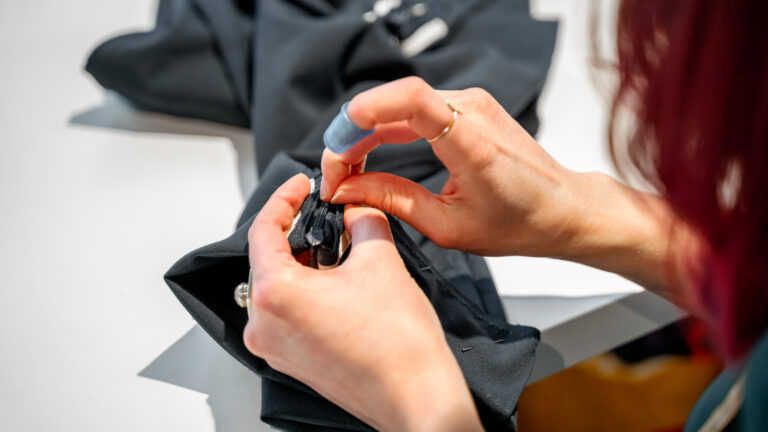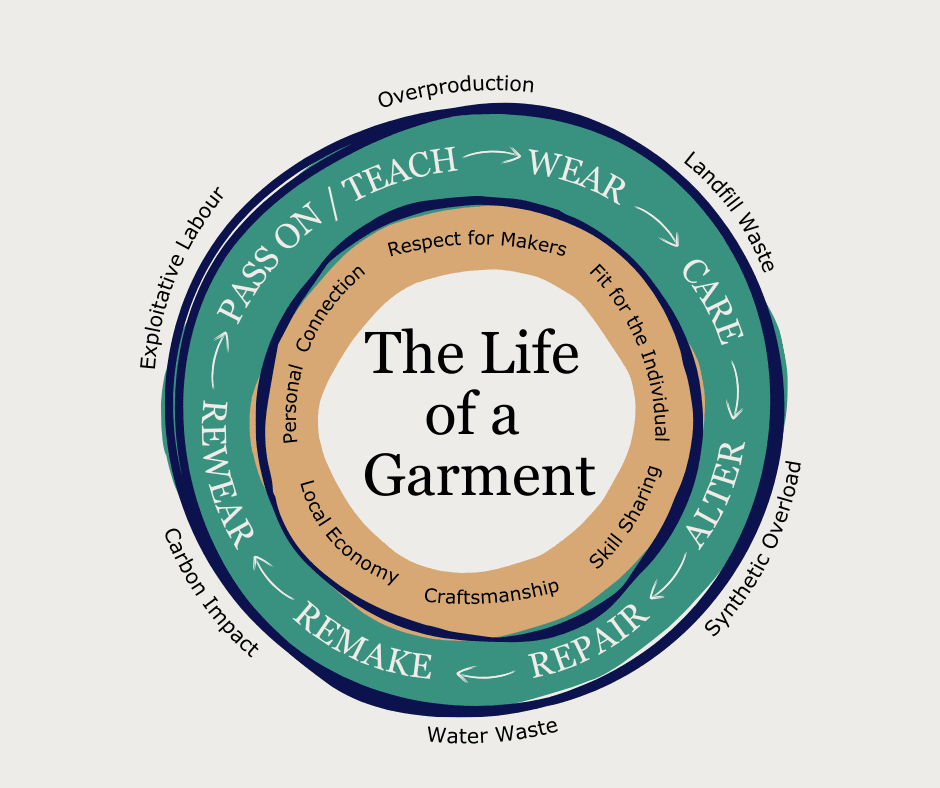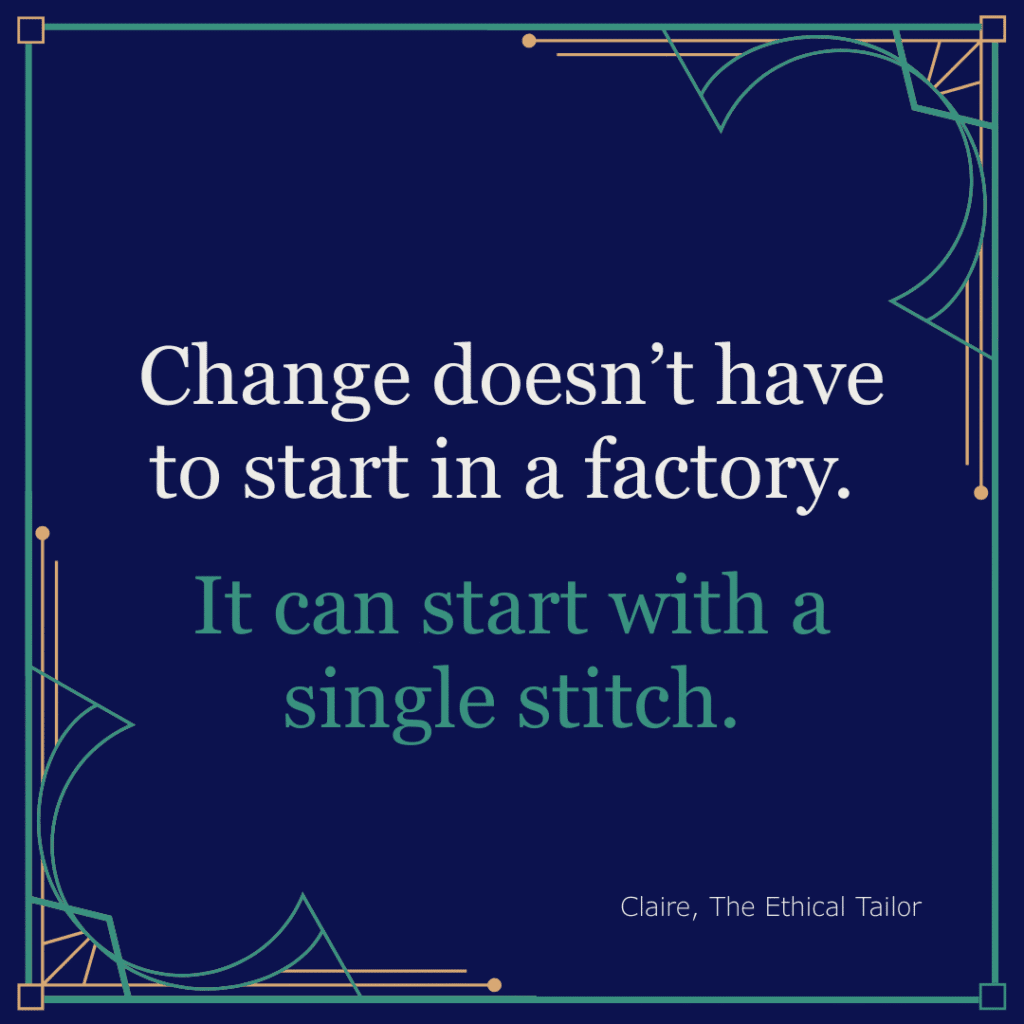
♻️ Rewear and Repair: My Thoughts on Recycle Week
This Recycle Week, I’ve been thinking a lot about what it really means to rewear and repair — and why those actions matter more than

Hi, I’m Claire — The Ethical Tailor.
If you’ve ever been curious about circular fashion, you’re not alone. It’s a term that gets used a lot, often alongside words like “sustainable” or “zero waste.” But what does circularity really mean — and more importantly, what does it look like in everyday life?
At Couchman:bespoke, circularity isn’t a trend. It’s our starting point.
At its core, circular fashion is about designing, using, and reusing clothes in a way that reduces waste. Circular fashion turns away from the traditional take-make-dispose model. It values longevity and care — a slower rhythm of use and reuse that reduces waste.
In a circular system, garments are made to last. They’re cared for, altered, passed on, or remade. Nothing is wasted, and everything is valued — especially the people behind the clothes.
And this is where tailoring comes in.
You can visualise this idea using our Life of a Garment diagram (above) — inspired by the Doughnut Economics model. At the centre are the values that hold ethical fashion together: respect for makers, personal connection, local economy, and skilled craftsmanship. Around that, you’ll see the garment’s circular journey — from wear and care, through alterations, repairs, remakes, and eventually passing it on. And encircling it all are the consequences we aim to avoid: landfill waste, overproduction, synthetic overload, and more. Ultimately, it’s a reminder that how we treat our clothes matters — not just to us, but to the systems we’re part of.
When you alter or repair a garment, you extend its life. When you reuse leftover fabric for something new, you close a loop. And when you teach someone to sew or mend, you pass on the skills that keep those loops going.
Here are just a few ways we support circularity every day:
✔ Zero-Waste Design: We design and cut with intention. Offcuts are reused or repurposed.
✔ Repair & Alteration Services: We bring your well-loved garments back to life — so they fit you, not a factory spec.
✔ Sewing Education: Through Moxie Craft, we teach people to repair, upcycle, and reconnect with their clothes.
✔ Community Support: We collaborate with local initiatives to promote slow fashion and garment longevity.
Circular fashion isn’t about being perfect. Instead, it’s about being practical and mindful. The system doesn’t have to be big or complex. It just needs to be human.
As fast fashion accelerates, so must our resistance. The UK alone throws away around 350,000 tonnes of clothes a year [source]. Globally, we’re producing more than we can possibly wear — and discarding even faster.
But change doesn’t have to start in a factory. It can start with a single stitch.
When you choose to repair instead of replace, alter instead of abandon, or make something new from what already exists — you’re not just saving a garment. You’re reshaping the future of fashion.

Circularity is about care. For the planet. For people. For the things we wear.
If you have clothes in your wardrobe that you’d love to wear again, or want to learn how to bring them back to life — I’d love to help.
🧵 Book a tailoring or repair service
✂️ Join a Moxie Craft class and learn the skills for yourself
Interested in how others are championing circular fashion? Here are a few inspiring accounts and initiatives worth exploring:

This Recycle Week, I’ve been thinking a lot about what it really means to rewear and repair — and why those actions matter more than

I, The Ethical Tailor, invite you to slow down and stitch with purpose. Hosted in London, this garment repair workshop is part of CHEEKY LONDON 25.

A big part of bespoke tailoring is knowing where to find the right materials — and for me, that means knowing the best fabric and
| Cookie | Duration | Description |
|---|---|---|
| cookielawinfo-checkbox-analytics | 11 months | This cookie is set by GDPR Cookie Consent plugin. The cookie is used to store the user consent for the cookies in the category "Analytics". |
| cookielawinfo-checkbox-functional | 11 months | The cookie is set by GDPR cookie consent to record the user consent for the cookies in the category "Functional". |
| cookielawinfo-checkbox-necessary | 11 months | This cookie is set by GDPR Cookie Consent plugin. The cookies is used to store the user consent for the cookies in the category "Necessary". |
| cookielawinfo-checkbox-others | 11 months | This cookie is set by GDPR Cookie Consent plugin. The cookie is used to store the user consent for the cookies in the category "Other. |
| cookielawinfo-checkbox-performance | 11 months | This cookie is set by GDPR Cookie Consent plugin. The cookie is used to store the user consent for the cookies in the category "Performance". |
| viewed_cookie_policy | 11 months | The cookie is set by the GDPR Cookie Consent plugin and is used to store whether or not user has consented to the use of cookies. It does not store any personal data. |